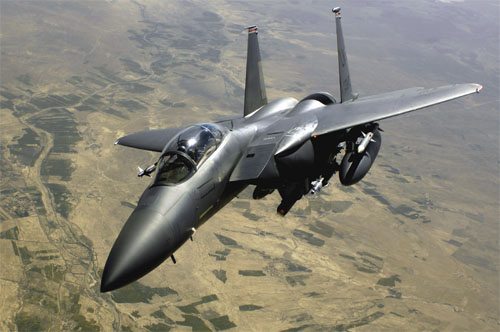Introduction
A fighter aircraft is a military aircraft designed primarily for attacking other aircraft, as opposed to a bomber, which is designed to attack ground targets, primarily by dropping bombs. Fighters are comparatively small, fast, and highly maneuverable, and have been fitted with increasingly sophisticated tracking and weapons systems to intercept and attack other aircraft.
At one time, just before the opening of World War II, there were two types of fighters. Smaller single-engine planes were used as interceptors and day fighters, sometimes referred to as pursuit, while larger twin-engine designs were used as heavy fighters. The latter role proved to be unworkable, or at least not enough effort was put into them to remain useful. They then found themselves being converted to an ever-growing list of secondary roles, including strike fighters, bomber destroyers and night fighters, where their two engines gave them the increased payload needed to fill these roles.
Fighter aircraft were developed during World War I, when they were tasked with hunting down enemy reconnaissance aircraft and balloons. Engine power was so limited that they were barely able to lift themselves, but by the end of the war they had become one of the primary designs in the inventory.
In the 1950s, jet-engined fighter planes capable of supersonic flight were developed. Power remained low, and the designs were dedicated to specific roles. Any particular air force might deploy three or four designs, day fighters, night fighters, attack planes, etc
These distinctions continued to erode during the 1960s, not always with good results. The McDonnell F-4 Phantom II was designed as a pure interceptor for the US Navy, but became a highly successful multi-role aircraft for the US Air Force and US Marine Corps as well as many other nations. Only a few years later, however, the General Dynamics F-111, intended as a multi-role, multi-service fighter, proved to be a near-disaster, so ineffectual as a fighter that the Navy version was abandoned, and the type eventually matured as bomber. Budgetary and political realities have increasingly forced the development of multi-role rather than specialized aircraft, but with some notable exceptions (like the F/A-18 Hornet), the demands of a good attack aircraft and a good air combat fighter remain somewhat mutually exclusive.
Current developments include reducing the radar visibility of fighters–techniques known as stealth–as well as increased range at supersonic speeds (supercruise) and better maneuverability. Ultimately, most authorities believe that there is no future for crewed fighter planes as they will eventually be replaced by Unmanned Combat Air Vehicles (UCAV) . However, the world’s major air forces are all in the process of replacing their craft with a new generation of planes, so the transition is likely some time away yet.
Background Info and Historical overview
1914-1918
- French aviator Roland Garros was decorated for his innovative machine gun attachment to his plane, which fired bullets through the propeller. Although the design eventually fell into German hands, Garros used it to shoot down three enemy aircraft.
- Significant aircraft:
- Nieuport
- Rumpler Taube
- Fokker: Fokker Dr.I, Fokker D.VII
- S.P.A.D., or "Spad"
- Sopwith Camel
- RAE SE5a
- Albatros
1919-1938
1939-1945
- Australia
- CAC Boomerang
- France
- Dewoitine D.520
- See also List of aircraft of the Armée de l’Air, World War II
- Germany
- Messerschmitt Bf 109
- Messerschmitt Bf 110
- Focke-Wulf Fw 190
- Messerschmitt Me 163
- Messerschmitt Me 262
- Heinkel He 162
- See also List of aircraft of the Luftwaffe, World War II
- Italy
- Macchi C.202
- Macchi C.205
- Japan
- Kawanishi N1K-J
- Mitsubishi Zero
- Latvia
- VEF Irbitis I-16
- Poland
- PZL P.7a
- PZL P.11c
- Soviet Union
- Mikoyan-Gurevich MiG-3
- Lavochkin La-5
- Yakovlev Yak-9
- United Kingdom
- Supermarine Spitfire
- Hawker Hurricane
- Hawker Typhoon
- Hawker Tempest
- De Havilland Mosquito
- Gloster Meteor
- United States
- Vought F4U Corsair
- Grumman F6F Hellcat
- Lockheed P-38 Lightning
- Bell P-39 Airacobra
- Curtiss P-40
- Republic P-47 Thunderbolt
- North American P-51 Mustang
- See also List of aircraft of the USAAF, World War II
- Sweden
- Saab J21
- Yugoslavia
- IK-3
1945-1952
- United States
- Lockheed P-80 Shooting Star
- Republic F-84 Thunderjet
- North American F-86 Sabre
- Northrop F-89J Scorpion
- Lockheed F-94C Starfire
- Grumman Panther
- Grumman Cougar
- McDonnell XF-85 Goblin
- Douglas F4D Skyray
- U.S.S.R
- Mikoyan-Gurevich MiG-15
- Mikoyan-Gurevich MiG-17
- United Kingdom
- de Havilland Vampire
- Hawker Hunter
- English Electric Lightning
- France
- Dassault MD 450
- Dassault Mystere IVB
- Dassault MD 550 Mirage I
- Sweden
- Saab Tunnan
- Saab Lansen
1953-present (Modern fighters)
- Canada
- Avro CF-100
- Avro Arrow
- Europe
- Panavia Tornado
- Eurofighter Typhoon
- France
- Dassault Super Etendard
- Dassault Mirage III
- Dassault Mirage F1
- Dassault Mirage 2000
- Dassault Rafale
- Japan
- Mitsubishi F-2
- U.S.
- North American F-100 Super Sabre
- Republic F-105 Thunderchief
- Convair F-106 Delta Dart
- Douglas F5D Skylancer
- Northrop F-5 Freedom Fighter
- Lockheed F-104 Starfighter
- F-111 Aardvark
- RF-101 Voodoo
- F-4 Phantom II
- F-14 Tomcat
- F-15 Eagle
- F-16 Fighting Falcon
- F-117 Nighthawk
- F/A-18 Hornet
- U.S.S.R
- Mikoyan-Gurevich MiG-19
- Mikoyan-Gurevich MiG-21
- Mikoyan-Gurevich MiG-23
- Mikoyan-Gurevich MiG-25
- Mikoyan-Gurevich MiG-29
- Sukhoi Su-24
- Sukhoi Su-27
- Sweden
- Saab Draken
- Saab Viggen
- Saab Gripen
- United Kingdom
- English Electric Lightning
- Hawker Siddeley Harrier
- Yugoslavia
- Soko J-1 Jastreb
- Soko J-22 Orao
Recently Introduced, Experimental and Proposed Future Designs
-
- U.S.
- F/A-22 Raptor
- U.S. and U.K.
- F-35 Joint Strike Fighter
- Russia
- MiG-35
- Su-47
- India
- HAL Tejas
- France
- Dassault Neuron
- China
- J-10
- Pakistan and China
- JF-17
- U.S.








